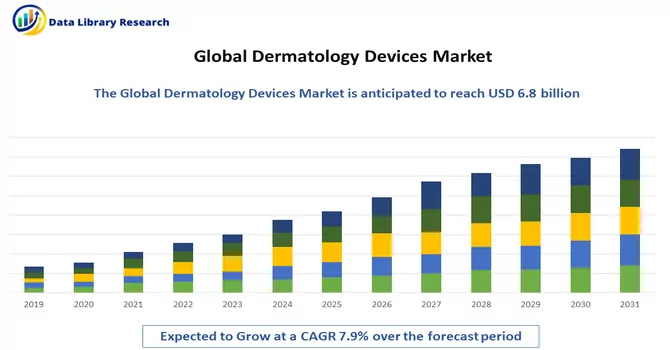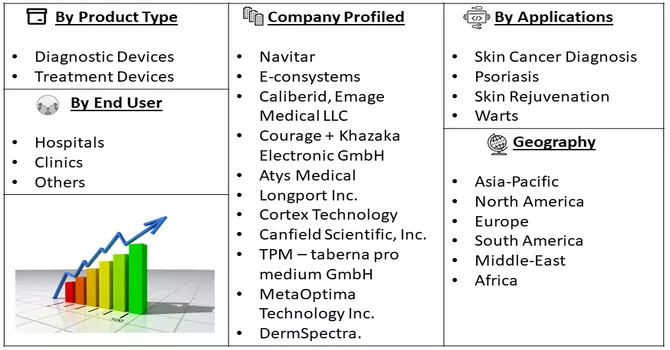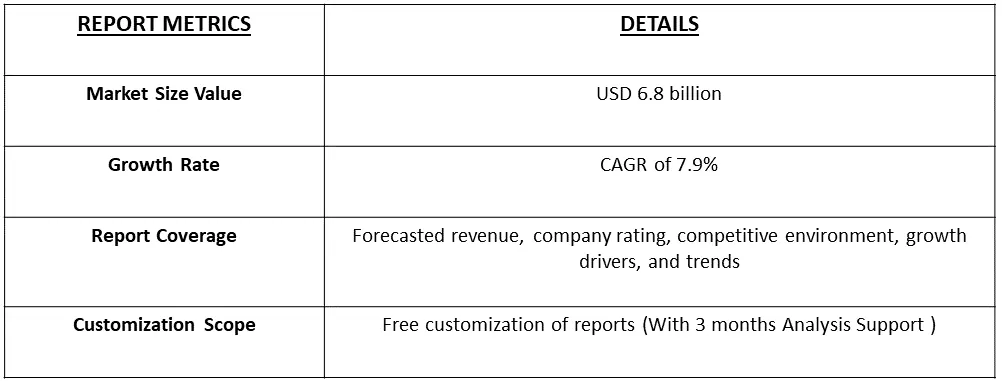The global dermatology devices market in terms of revenue was estimated to be worth USD 6.8 billion in 2022 and is expected to register a CAGR of 7.9% over the forecast period, 2023-2031.

Get Complete Analysis Of The Report - Download Free Sample PDF
The dermatology devices market refers to the sector within the medical industry that encompasses a wide range of medical devices specifically designed for the diagnosis, treatment, and monitoring of skin-related conditions and disorders. These devices are utilized by dermatologists, healthcare professionals, and skincare specialists to address various dermatological issues, ranging from common skin conditions to more complex disorders.
The rising incidence of skin conditions, including dermatitis, psoriasis, acne, and skin cancer, is a significant driver for the dermatology devices market. The demand for diagnostic and treatment solutions is growing with the increasing prevalence of these skin disorders. Also, increasing awareness and acceptance of aesthetic procedures for skin rejuvenation, anti-ageing, and cosmetic enhancements drive the demand for dermatology devices. Devices offering non-invasive or minimally invasive treatments are particularly sought after.
Market Segmentation: The Dermatology Devices Market is Segmented by Diagnostic device type (Imaging Devices, Dermatoscopes, and Microscopes), Diagnostic Devices Application (Skin Cancer Diagnosis, and Other Diagnostic Device Applications), Treatment Devices Type (Light Therapy Devices, Lasers, Electrosurgical Equipment, Liposuction Devices, Microdermabrasion Devices, and Cryotherapy Devices), Treatment Devices Application (Vascular Lesions, Acne, Psoriasis, and Tattoo Removal, Hair Removal, Wrinkle Removal, Body Contouring and Fat Removal, and Other Treatment Device Applications), and Geography (North America, Europe, Asia-Pacific, Middle East and Africa, and South America). The report offers the value (in USD million) for the above-mentioned segments.

For Detailed Market Segmentation - Download Free Sample PDF
The increasing adoption of telemedicine and teledermatology is a significant trend. Dermatology devices integrated with digital platforms facilitate remote consultations, skin monitoring, and treatment planning, enhancing accessibility to dermatological care. Moreover, the ongoing technological advancements in laser and light-based dermatology devices continue to drive market trends. Innovations in these technologies offer more precise and effective treatments for various skin conditions, including hair removal, skin resurfacing, and pigmentation disorders. Furthermore, the integration of artificial intelligence (AI) in dermatology devices is a growing trend. AI is being utilized for image analysis, diagnostics, and treatment planning, enhancing the efficiency and accuracy of dermatological assessments. These trends collectively reflect the dynamic nature of the dermatology devices market, with a strong focus on technological innovation, patient-centric solutions, and the convergence of skincare with digital health technologies.
Market Drivers:
Rising Incidences of Skin Disorders and Increasing Awareness of Aesthetic Procedures
The escalating global demand for aesthetic procedures is contributing to the increased necessity for dermatological devices, thereby fostering market growth. Notably, data from the International Society of Plastic Surgeons, as of December 2021, revealed substantial figures for aesthetic/cosmetic procedures performed worldwide in 2020. Notable procedures included breast augmentation (1,624,281), liposuction (1,525,197), eyelid surgery (1,225,540), rhinoplasty (852,554), and abdominoplasty (765,248). Additionally, the market is experiencing growth propelled by the introduction of technologically advanced products. A case in point is the December 2021 launch of the Skintrinsiq device by Obagi, a leading science-based skincare company renowned for its professional skincare products. This marked Obagi's foray into the complementary skincare device market. The Skintrinsiq device stands out as one of the pioneering professional-use facial devices, offering an advanced delivery system for Obagi's transformative skincare products. The convergence of increasing aesthetic procedure trends and innovative product launches is contributing significantly to the positive momentum in the dermatological devices market.
Technological Advancements in Skin Care Devices
In June 2022, Casio Computer Co., Ltd. took a significant step by issuing an EU Declaration of Conformity for its DZ-D100 dermatology camera and DZ-S50 dermatology scope. This declaration followed the successful completion of conformity studies aligned with the European Medical Device Regulations (MDR). Notably, Casio anticipates the official launch of the DZ-D100 and DZ-S50 in Europe in August 2022, with sales slated to be conducted through Casio Europe GmbH (Norderstedt, Germany) and Casio Electronics Co. Ltd. (Wembley, UK). These proactive measures, including compliance with regulatory standards and strategic product launches, are poised to exert a positive influence on the market's growth trajectory. Casio's commitment to meeting regulatory requirements and introducing advanced dermatology devices reflects a concerted effort to cater to the evolving needs of the European market and contribute to the overall expansion of the dermatology devices sector.
Market Restraints:
Side Effects Related To Dermatological Treatments and Stringent Regulatory Policies for Medical Devices
Dermatological treatments, especially those involving advanced devices, may be associated with side effects that can impact patient satisfaction and safety. Common side effects include redness, swelling, bruising, and, in some cases, more severe complications such as scarring or pigmentation changes. The occurrence of adverse effects can lead to concerns among both patients and healthcare professionals, potentially affecting the adoption of certain dermatology devices. The dermatology devices market operates in an environment characterized by stringent regulatory frameworks governing the approval and marketing of medical devices. Regulatory agencies, such as the U.S. Food and Drug Administration (FDA) and the European Medicines Agency (EMA), impose rigorous standards to ensure the safety and efficacy of dermatology devices. While these regulations are crucial for patient safety, they can pose challenges for manufacturers in terms of navigating complex approval processes and meeting stringent requirements. Thus, such factors can slow down the growth of the studied market.
Segmental Analysis:
Imaging Devices Segment is Expected to Witness Significant Growth Over the Forecast Period
Imaging devices play a crucial role in the field of dermatology, providing healthcare professionals with advanced tools for the visualization, diagnosis, and monitoring of various skin conditions. These devices utilize cutting-edge technologies to capture detailed images of the skin, enabling dermatologists to assess lesions, diagnose diseases, and plan appropriate treatments. Dermatoscopes are handheld devices designed for magnifying and visualizing skin lesions. They enable dermatologists to examine moles, pigmented lesions, and other skin abnormalities with enhanced clarity. Other devices like OCT is a non-invasive imaging technique that uses light waves to capture cross-sectional images of the skin. It provides detailed insights into skin structures, making it useful for assessing epidermal and dermal layers. OCT is employed in dermatology for diagnosing skin cancers, monitoring treatment outcomes, and studying skin conditions such as psoriasis and eczema. Thus, the growth of the segment is expected to witness significant growth over the forecast period.
Skin Cancer Diagnosis Segment is Expected to Witness Significant Growth Over the Forecast Period
Skin cancer diagnosis is a critical aspect of dermatology, as dermatologists play a key role in identifying and treating various types of skin cancers. Dermatologists utilize a combination of clinical examination, imaging techniques, and pathological analysis to accurately diagnose skin cancer. Dermatologists perform a thorough visual inspection of the skin to identify any suspicious lesions. They assess the size, colour, shape, and borders of moles or other skin abnormalities. Dermatoscopy involves using a handheld device called a dermatoscope to magnify and visualize skin lesions. It helps dermatologists assess the internal structures of pigmented lesions. Thus, the segment is expected to witness significant growth over the forecast period.
The Lasers Segment is Expected to Witness Significant Growth Over the Forecast Period
Lasers play a pivotal role in dermatology, offering a versatile and effective approach to treating various skin conditions. Dermatological laser procedures leverage the precise delivery of light energy to target specific skin structures, allowing dermatologists to address concerns ranging from pigmentation and vascular issues to unwanted hair and signs of ageing. Lasers target the melanin in hair follicles, leading to selective photothermolysis and permanent hair reduction. Also, lasers target melanin in pigmented lesions, such as age spots or sunspots, resulting in their fragmentation and subsequent removal. Thus, the segment is expected to witness significant growth over the forecast period.
Acne, Psoriasis, and Tattoo Removal Segment is Expected to Witness Significant Growth Over the Forecast Period
Dermatology devices play a crucial role in addressing acne, a common skin condition characterized by the presence of pimples, blackheads, and whiteheads. Also, blue light therapy devices emit specific wavelengths of light that target acne-causing bacteria (Propionibacterium acnes), reducing inflammation and promoting clearer skin. Dermatology devices for acne, psoriasis, and tattoo removal are continually evolving, offering patients and dermatologists innovative solutions for various skin conditions. The selection of the most suitable device depends on factors such as the specific skin condition, patient characteristics, and treatment goals.
North America Region is Expected to Witness Significant Growth Over the Forecast Period
North America has been a major player in the dermatology devices market, and this trend is expected to continue. The region's dominance is driven by the increasing cases of skin cancer, eczema, and rosacea, alongside the approval of dermatological devices and a growing awareness of aesthetic procedures. Recent data from the American Cancer Society in 2022 reveals an estimated 99,780 new cases of skin melanoma in the United States alone, with 57,180 cases projected for males and 42,600 for females. This surge in skin cancer and related conditions significantly fuels the demand for dermatology devices, contributing to the market's growth. Thus, the combination of a rising prevalence of skin disorders, approvals for innovative dermatology devices, and a focus on advanced patient care, the dermatology devices market in North America is poised for substantial growth in the coming years.

Get Complete Analysis Of The Report - Download Free Sample PDF
The dermatology devices market exhibits a moderate level of competitiveness, with key players actively enhancing their portfolios through continuous innovation. This involves improvements to existing products to meet evolving market demands. These players are strategically adopting growth initiatives to broaden their product range, reinforce their market presence across geographical regions, and expand their customer base. The market landscape is characterized by ongoing efforts from industry participants to introduce innovative features and technologies into their dermatology devices. This approach aims to stay ahead in the competitive landscape by providing advanced solutions that address the evolving needs of healthcare professionals and patients.The key players operating in the studied market include:
Recent Developments:
1) In June 2022, Cynosure introduced the PicoSure Pro, the latest advancement in its PicoSure platform. Notably, the PicoSure Pro stands out as one of the first picosecond lasers with 755nm wavelength clearance from the United States Food and Drug Administration (FDA).
2) Skin Science Solutions made a significant entry into the market in April 2022 with the launch of ICOONE Roboderm. This cutting-edge device employs innovative cellular technologies to provide facial and body rejuvenation procedures that are both painless and non-invasive. The newly introduced income treatment is now accessible at the Exhale Spa, conveniently located within the NoMad Hotel in New York City.
Q1. What was the Dermatology Devices Market size in 2022?
As per Data Library Research the global dermatology devices market in terms of revenue was estimated to be worth USD 6.8 billion in 2022.
Q2. At what CAGR is the dermatology devices market projected to grow within the forecast period?
Dermatology Devices Market is expected to register a CAGR of 7.9% over the forecast period.
Q3. What are the factors driving the Dermatology Devices market?
Key factors that are driving the growth include the Rising Incidences of Skin Disorders and Increasing Awareness of Aesthetic Procedures and Technological Advancements in Skin Care Devices.
Q4. Which region has the largest share of the Dermatology Devices market? What are the largest region's market size and growth rate?
North America has the largest share of the market . For detailed insights on the largest region's market size and growth rate request a sample here.
Data Library Research are conducted by industry experts who offer insight on industry structure, market segmentations technology assessment and competitive landscape (CL), and penetration, as well as on emerging trends. Their analysis is based on primary interviews (~ 80%) and secondary research (~ 20%) as well as years of professional expertise in their respective industries. Adding to this, by analysing historical trends and current market positions, our analysts predict where the market will be headed for the next five years. Furthermore, the varying trends of segment & categories geographically presented are also studied and the estimated based on the primary & secondary research.
In this particular report from the supply side Data Library Research has conducted primary surveys (interviews) with the key level executives (VP, CEO’s, Marketing Director, Business Development Manager and SOFT) of the companies that active & prominent as well as the midsized organization
FIGURE 1: DLR RESEARH PROCESS

Extensive primary research was conducted to gain a deeper insight of the market and industry performance. The analysis is based on both primary and secondary research as well as years of professional expertise in the respective industries.
In addition to analysing current and historical trends, our analysts predict where the market is headed over the next five years.
It varies by segment for these categories geographically presented in the list of market tables. Speaking about this particular report we have conducted primary surveys (interviews) with the key level executives (VP, CEO’s, Marketing Director, Business Development Manager and many more) of the major players active in the market.
Secondary ResearchSecondary research was mainly used to collect and identify information useful for the extensive, technical, market-oriented, and Friend’s study of the Global Extra Neutral Alcohol. It was also used to obtain key information about major players, market classification and segmentation according to the industry trends, geographical markets, and developments related to the market and technology perspectives. For this study, analysts have gathered information from various credible sources, such as annual reports, sec filings, journals, white papers, SOFT presentations, and company web sites.
Market Size EstimationBoth, top-down and bottom-up approaches were used to estimate and validate the size of the Global market and to estimate the size of various other dependent submarkets in the overall Extra Neutral Alcohol. The key players in the market were identified through secondary research and their market contributions in the respective geographies were determined through primary and secondary research.
Forecast Model
